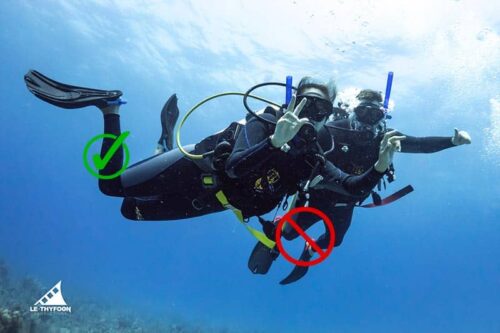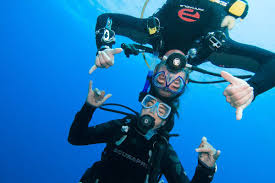Mastering Your Trim: The Secret of Graceful, Efficient Divers
Have you ever watched a dive instructor or a technical diver move underwater? They seem to glide effortlessly, their body perfectly flat and horizontal, fins gently propelling them without a single wasted motion. That isn’t magic; it’s the result of mastering a foundational skill called “trim.”
In this in-depth article from Amadive’s Mastering Core Dive Skills series, we will analyze why achieving a horizontal trim is about so much more than just “looking good.” It is a fundamental element that affects every aspect of your dive, from your air consumption and safety to your impact on the environment.
What is Good Trim vs. Bad Trim?

- Bad Trim (The “Seahorse” Position): This is the typical posture of a new diver. The body is at a diagonal angle, head up and fins down. The fins are constantly kicking just to keep the body from sinking.
- Good Trim (The “Submarine” Position): The body is flat and parallel to the seabed. The knees are bent at a 90-degree angle, with the fins pointing up and away from the reef. The entire body forms a streamlined profile.
Why Good Trim is So Vitally Important: The Four Key Benefits

1. Hydrodynamic Efficiency (Reduced Drag)
Imagine trying to push a wooden plank through the water. Would you push it flat-side first, or edge-first? The “seahorse” position is like pushing the flat side. It creates a massive amount of drag.
- The Consequence: You have to work much harder to move, leading to faster breathing and significantly higher air consumption.
- The Benefit of Good Trim: A horizontal, streamlined profile minimizes drag. You glide effortlessly after each fin kick, conserving maximum energy and air.
2. Protecting the Marine Environment
- The Problem with Bad Trim: When your fins are pointing down, every kick risks hitting fragile coral or stirring up the sandy bottom, which reduces visibility for the whole group and harms bottom-dwelling organisms.
- The Benefit of Good Trim: With a horizontal trim and fins pointed up, you can swim inches above a reef without making any impact. This is the mark of a conscious and respectful diver.
3. The Foundation for Advanced Skills
You cannot efficiently perform finning techniques like the Frog Kick or Helicopter Turn if you are not in a stable, balanced position. Good trim is the “ready” position that allows you to execute all other skills with ease, from deploying an SMB to taking a sharp photograph.
4. Enhanced Situational Awareness
When you are horizontal, your field of vision is directed forward, scanning the environment. In the “seahorse” position, you tend to be looking down, missing what is happening around and in front of you.
How to Achieve Perfect Trim: A Step-by-Step Guide
Achieving good trim is a combination of two factors: weight distribution and body posture.
- Step 1: Get Your Weighting Right: This is the first and most critical step. Being overweighted is the enemy of good trim. Perform a proper buoyancy check: with a nearly empty tank (50 bar) and no air in your BCD, you should float at eye level while holding a normal breath.
- Step 2: Redistribute Your Weights (E-E-A-T: Expertise):
- The Problem: Most people wear all their weight on a hip belt, which acts like an anchor pulling their legs down.
- The Solution: Move your center of gravity higher.
- Use Trim Pockets: These are small weight pockets located on the shoulders or tank band of a BCD. Moving 1-2 kg (2-4 lbs) from your hips to these pockets can have a dramatic effect on lifting your legs.
- Use a V-Weight or Backplate System: For wing-style BCDs, placing weight directly on the backplate provides perfect distribution.
- Step 3: Adjust Your Cylinder Position:
- The Principle: The position of your tank affects your balance.
- How-To: If your legs still tend to sink, try lowering the tank a few centimeters in the BCD’s cam band. If your upper body sinks, try raising the tank slightly.
- Step 4: Use Your Body Posture:
- The “Sky Diver” Arch: Imagine you are a skydiver. A slight arch in your lower back, shoulders back, and knees bent 90 degrees will naturally stabilize and flatten your body.
Conclusion: Small Changes, Huge Impact
Taking the time to perfect your trim is one of the most effective investments you can make in your diving. It doesn’t require expensive gear, just understanding and a few small adjustments. Once you experience the feeling of gliding effortlessly through the water in perfect trim, you will never want to go back.
